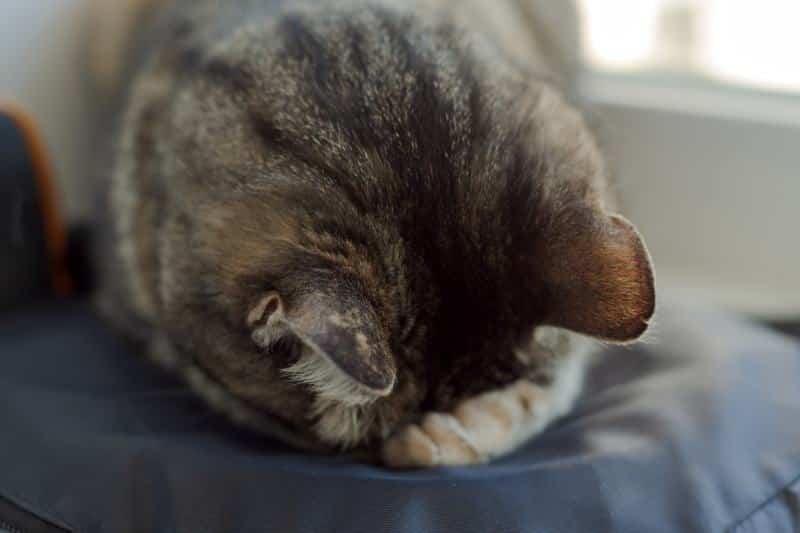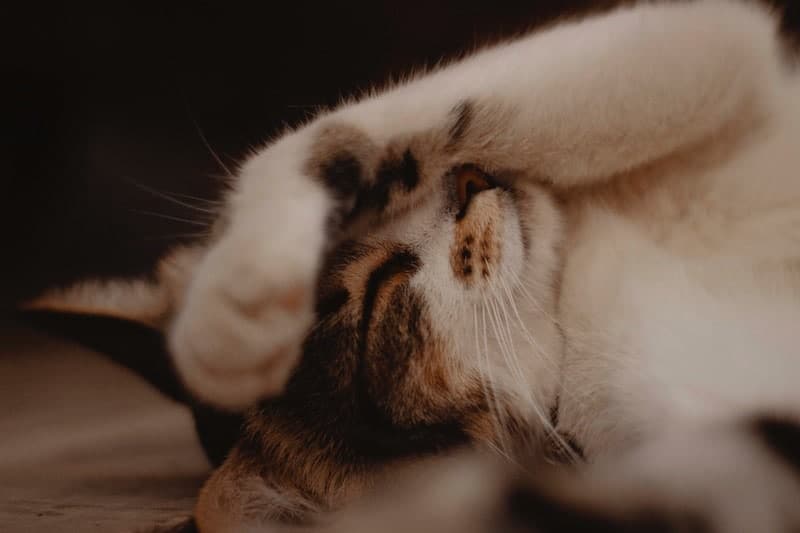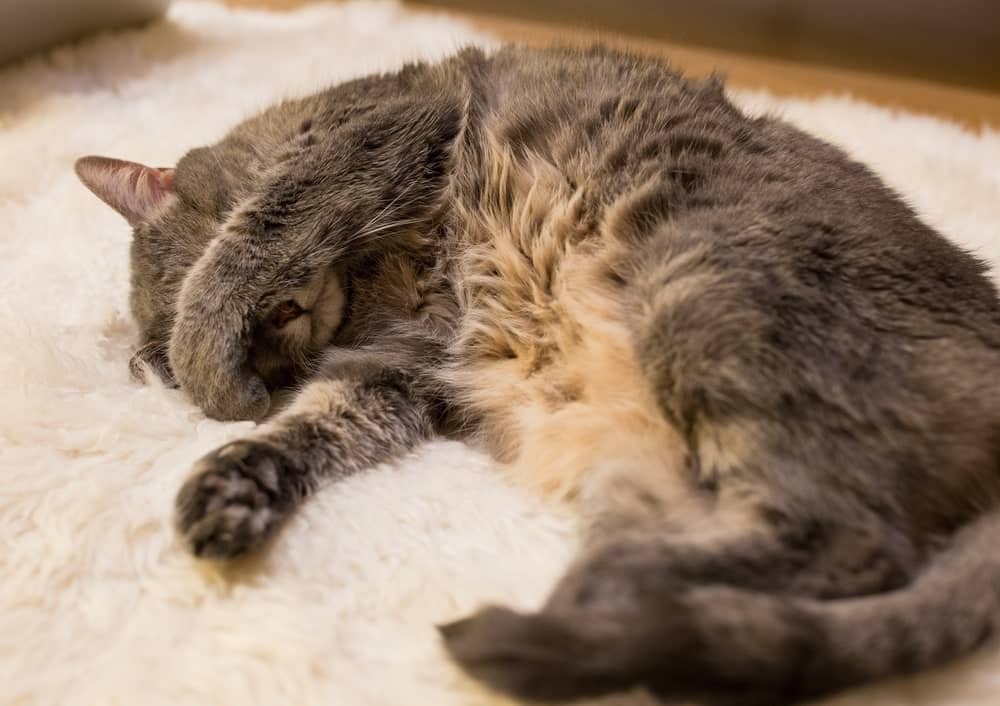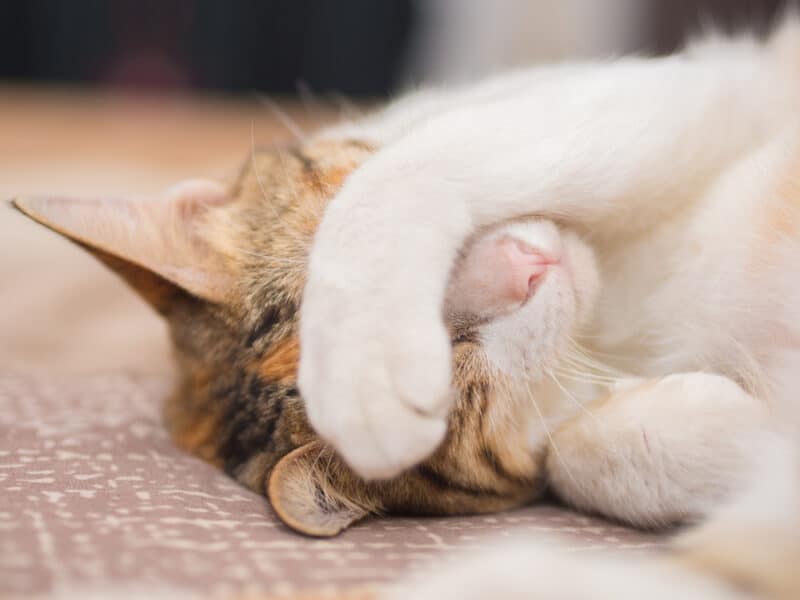Cats are adorable when they sleep, which is good because they spend so much time snoozing throughout the day and night. You have undoubtedly noticed quirky behaviors in your cat while they sleep, such as covering their face with their paws. You might wonder if it is normal behavior or if it means something is wrong.
Whether you are dealing with a kitten, an adult, or a senior, there are a few reasons that your cat might cover their face with their paws when they settle down for a nice cozy nap, such as to be comfortable and keep warm. Below, we’ll discuss a few other reasons.
The 8 Likely Reasons Why Cats Cover Their Faces When They Sleep
1. They’re Blocking Out the Light
Sometimes, it is too bright for a cat to get a good nap. Therefore, they cover their eyes with their paws to block the light. This is typical behavior for cats that want to sunbathe in a window while they snooze. If they are not using their paws to block the light, they might use their tail.
2. They Are Creating a Sense of Security
Cats don’t like to leave themselves exposed while they sleep, and in nature, it could result in an assault by a predator. Even when sleeping in the comfort of their home, they need to feel safe. Covering their face with their paws can give them an extra sense of security because it makes them feel like they are hidden away and cannot be seen as easily.

3. They Are Trying to Warm Themselves Up
If it’s chilly while your cat is napping, they might use their paws to cover their face to warm up. Covering their face can keep their nose warm, which, in turn, helps them retain their body heat. A cat trying to keep warm may also curl their body tightly around their head and paws.
4. They Don’t Want to Get Distracted
When a cat is tired, they do what they can to remove the distractions that keep them awake. One way for them to do it is to cover their face with their paws. A covered face minimizes the risk of getting startled and increases the chance of maintaining optimal comfort during a nap.

5. They Simply Find It Comfortable
Some cats cover their faces when they sleep just for comfort. It’s like when we wrap our arms around a throw pillow or tuck blankets between our legs for extra comfort during a nap. Not all cats find covering their faces a comfortable sleeping position, but those that do are likely to cover their faces often.
Is there anything better than a happy cat? We don’t think so—that’s where the Hepper Nest Bed comes in.
This product was designed with both your and your kitty's happiness in mind. While the comfortable bowl shape and wide lip to rest their heads on are ideal for sleepy kitties, you’ll appreciate the removable and machine-washable fleece liner for easy cleaning. It doesn’t get any better than this! Click here to try it out. At Catster, we’ve admired Hepper for many years and decided to take a controlling ownership interest so that we could benefit from the outstanding designs of this cool cat company!
6. They Are Making It Clear That They Don’t Want to Be Disturbed
Sometimes, a cat might cover their face while they sleep as a sign that they do not want human or other animal companions in the home to disturb them. They want peace and feel that if they block everyone out with their paws, their message will be read loud and clear.
You will know that this is why your cat’s covered face if they react negatively when you try to pet, pick up, or talk to them while they are sleeping.

7. They Are Exhausted and Can’t Stay Awake Any Longer
Cats like to groom themselves almost as much as they enjoy exploring and sleeping. If they happen to be cleaning their paws or face when they’re tired, they might fall asleep in the middle of the process and end up covering their face with their paws. It’s simply the position that they are in when they doze off, and they stay that way out of convenience.
8. They May Be Marking Their Territory
While this is not a common reason for a cat to cover their face while they sleep, it is still possible. Cats love to mark their territory by rubbing their bodies on objects and spaces they “own.” The odor from their body gets onto the objects and spaces where other cats can smell it and understand that ownership has been established.
Your kitty might be rubbing their head on a pillow, blanket, or area rug to mark territory and then fall asleep in the process, making it look like they’re covering their face while they snooze.

Conclusion
Regardless of why your cat covers their face while they sleep, there is no reason to worry about their health or behavior. Covering their face while they sleep is normal behavior for most felines, even if they only do it occasionally. However, understanding why your cat engages in the behavior can provide you with peace of mind and insight.
Featured Image Credit: Ivan Olianto, Shutterstock
Contents
- The 8 Likely Reasons Why Cats Cover Their Faces When They Sleep
- 1. They’re Blocking Out the Light
- 2. They Are Creating a Sense of Security
- 3. They Are Trying to Warm Themselves Up
- 4. They Don’t Want to Get Distracted
- 5. They Simply Find It Comfortable
- 6. They Are Making It Clear That They Don’t Want to Be Disturbed
- 7. They Are Exhausted and Can’t Stay Awake Any Longer
- 8. They May Be Marking Their Territory
- Conclusion











